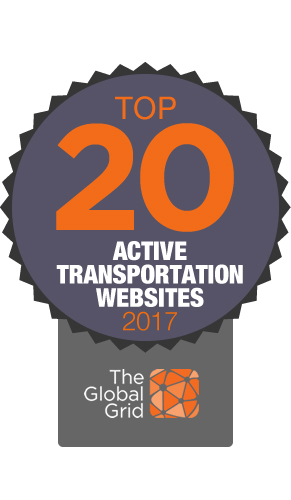About
One of the greatest challenges facing the bicycle and pedestrian field is the lack of documentation on usage and demand. Without accurate and consistent demand and usage figures, it is difficult to measure the positive benefits of investments in these modes, especially when compared to the other transportation modes such as the private automobile. An answer to this need for data is the National Bicycle & Pedestrian Documentation Project, co-sponsored by and Alta Planning and Design and the Institute of Transportation Engineers (ITE) Pedestrian and Bicycle Council. This nationwide effort provides a consistent model of data collection and ongoing data for use by planners, governments, and bicycle and pedestrian professionals.
Methodology
The basic assumptions of the methodology are that, in order to estimate existing and future bicycle and pedestrian demand and activity, agencies nationwide need to start conducting counts and surveys in a consistent manner similar to those being used by ITE and other groups for motor vehicle models.
NBPD to Provide Free Summary Reports!
The National Bicycle and Pedestrian Documentation Project has developed a summary report that highlights the valuable information that can be gained from year-long automatic bicycle and pedestrian counts. If your community uses Eco-Counter automatic count technology, the National Bicycle and Pedestrian Documentation Project will provide a free summary report of the data in exchange for submission of the annual automatic count data to the project. This report puts valuable information regarding usage and trends at your fingertips which can be used in grant applications, press releases, annual count reports, etc. Sample reports are available here and here. Email your Eco-Counter data in excel format to [email protected]. Please indicate the exact location of the automatic counter and tell us a bit about the bicycle or pedestrian facility.
News
- Have walking and bicycling increased in the US? A 13-year longitudinal analysis of traffic counts from 13 metropolitan areas. Recent scholarship from Virginia Tech that used NBPD data to create a national direct demand model. Huyen Le, Ralph Buehler, and Steve Hankey are the lead authors of the study.
- NCHRP Web-Only Document 229 has been published. This study is a follow up to NCHRP 797 and extends the automated bicycle and pedestrian count technology test from Round 1 to include radar, thermal imaging, plus additional pneumatic tube, passive infrared, and piezoelectric strip devices.
- Update to the National Cooperative Highway Research Program Report 797: NCHRP 797 Errata. This document corrects the results on piezoelectric strips. The corrected analysis of the counter shows that it was both highly precise and accurate. However, the researchers note that only one piezoelectric strip counter was tested and recommend further research.
- The National Cooperative Highway Research Program Report 797: Guidebook on Pedestrian and Bicycle Volume Data Collection is now available! The new report describes methods and technologies for counting bicycles and pedestrians. It offers advice to communities interested in selecting automated counting technology and shows the value of this work. The report was a joint effort between Kittelson & Associates, Inc., University of Wisconsin, University of California, Toole Design Group, and McGill University.
- Adjustment Factors Available: Adjustment factors are now availabe in an Excel format! While more year-long automatic count data is needed from different parts of the country, and especially for pedestrians and on-street bicyclists, enough data now exists to allow us to adjust counts done almost any period on multi-use paths and pedestrian districts to an annual figure. A detailed step by step explaination is available here.
- One of the longest and most extensive non-motorized transportation forecasting research projects (using the NBPD methodology) is now available for review. The 2.5 year Seamless Travel project was funded by Caltrans (California State Department of Transportation), overseen by SafeTREC (U.C. Berkeley), and led by Alta Planning + Design. The project used San Diego County as a case study and is the first of its type to (a) use 24-hr/day, 365-day/week automatic machine counters, 80 manual count/survey locations counted annually, and (b) develop an extensive GIS database of for analyzing and identifying factors that influence bicycling and walking. You can find the report here: Seamless Travel
- San Jose (California) completed it's 6th annual count in September 2012 and measured an over 12.1% increase in travel. Please follow the link to find a Fact Sheet and Summary Report on this year's count, survey and related analysis. http://www.sanjoseca.gov/
index.aspx?nid=5205 Data collection has helped in the pursuit of grant funding, advocating for sustained development, and budget for operations and maintenance.
- The Vancouver-Clark County Parks and Recreation (Washington) released its Fall 2010 Parks and Recreation Counts and Survey Report. Read it here: http://www.cityofvancouver.us/parks-recreation/parks_trails/trails/
- NBPD would like to thank the many agencies who sent us data and are excited about the great work done! For example:
- The volunteer based Sacramento, CA count effort continues to add count locations year after year!
- Using our extrapolation methods, the City of Vancouver estimates 2.5 million annual regional trail visits! See the report above for more details.
- The Intertwine Trail Use Snapshot, released by Metro, summarizes the first three years of regional trail count and survey data from the Portland Metro Region. Twelve different public agencies and over 1,000 volunteer hours contributed towards this data collection effort. Read the report here: http://library.oregonmetro.gov/files//intertwine_trail_use_snapshot_2008-2010.pdf
Email us at: [email protected]
